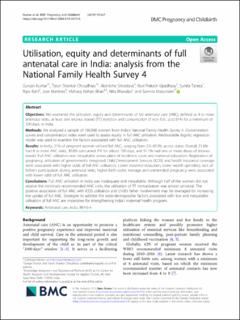| dc.contributor.author | Kumar, Gunjan | |
| dc.contributor.author | Choudhary, Tarun Shankar | |
| dc.contributor.author | Srivastava, Akanksha | |
| dc.contributor.author | Upadhyay, Ravi Prakash | |
| dc.contributor.author | Taneja, Sunita | |
| dc.contributor.author | Bahl, Rajiv | |
| dc.contributor.author | Martines, Jose Carlos | |
| dc.contributor.author | Bhan, Maharaj Kishan | |
| dc.contributor.author | Bhandari, Nita | |
| dc.contributor.author | Mazumder, Sarmila | |
| dc.date.accessioned | 2021-01-15T14:55:17Z | |
| dc.date.available | 2021-01-15T14:55:17Z | |
| dc.date.created | 2019-11-28T14:41:00Z | |
| dc.date.issued | 2019-09-05 | |
| dc.Published | BMC Pregnancy and Childbirth. 2019, 19, 327. | en_US |
| dc.identifier.issn | 1471-2393 | |
| dc.identifier.uri | https://hdl.handle.net/11250/2723321 | |
| dc.description.abstract | Objectives: We examined the utilisation, equity and determinants of full antenatal care (ANC), defined as 4 or more antenatal visits, at least one tetanus toxoid (TT) injection and consumption of iron folic acid (IFA) for a minimum of 100 days, in India.
Methods: We analysed a sample of 190,898 women from India’s National Family Health Survey 4. Concentration curves and concentration index were used to assess equity in full ANC utilisation. Multivariable logistic regression model was used to examine the factors associated with full ANC utilisation.
Results: In India, 21% of pregnant women utilised full ANC, ranging from 2.3–65.9% across states. Overall, 51.6% had 4 or more ANC visits, 30.8% consumed IFA for atleast 100 days, and 91.1% had one or more doses of tetanus toxoid. Full ANC utilisation was inequitable across place of residence, caste and maternal education. Registration of pregnancy, utilisation of government’s Integrated Child Development Services (ICDS) and health insurance coverage were associated with higher odds of full ANC utilisation. Lower maternal education, lower wealth quintile(s), lack of father’s participation during antenatal visits, higher birth order, teenage and unintended pregnancy were associated with lower odds of full ANC utilisation.
Conclusions: Full ANC utilisation in India was inadequate and inequitable. Although half of the women did not receive the minimum recommended ANC visits, the utilisation of TT immunisation was almost universal. The positive association of full ANC with ICDS utilisation and child’s father involvement may be leveraged for increasing the uptake of full ANC. Strategies to address the socio-demographic factors associated with low and inequitable utilisation of full ANC are imperative for strengthening India’s maternal health program. | en_US |
| dc.language.iso | eng | en_US |
| dc.publisher | BioMed Central | en_US |
| dc.rights | Navngivelse 4.0 Internasjonal | * |
| dc.rights.uri | http://creativecommons.org/licenses/by/4.0/deed.no | * |
| dc.title | Utilisation, equity and determinants of full antenatal care in India: analysis from the National Family Health Survey 4 | en_US |
| dc.type | Journal article | en_US |
| dc.type | Peer reviewed | en_US |
| dc.description.version | publishedVersion | en_US |
| dc.rights.holder | Copyright the authors. | en_US |
| cristin.ispublished | true | |
| cristin.fulltext | original | |
| cristin.qualitycode | 1 | |
| dc.identifier.doi | 10.1186/s12884-019-2473-6 | |
| dc.identifier.cristin | 1753910 | |
| dc.source.journal | BMC Pregnancy and Childbirth | en_US |
| dc.source.40 | 19 | en_US |
| dc.source.pagenumber | 327 | en_US |
| dc.relation.project | Norges forskningsråd: 223269 | en_US |

